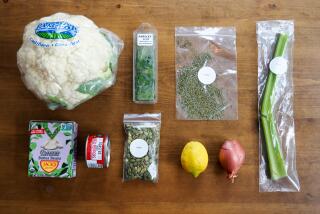For Safety’s Sake, Handle Chicken With Care
- Share via
A little bit of food safety knowledge can be a terrible thing when you go out to eat and watch your food being prepared by careless cooks.
There I was in line at a cafeteria, hungry for the salad with sauteed chicken advertised as the day’s lunch special.
The counter person was wearing gloves--a good sign, I suppose, although clean bare hands can be an experienced cook’s most valuable tool. She removed a tray of raw chicken from the refrigerator, stabbed a piece with her knife, set it on her cutting board, sliced it and placed the meat in a small saute pan.
She then wiped off the knife and cutting board with a hand towel and proceeded to slice a few tomatoes, chop some lettuce and assemble the salad. When the chicken was cooked, she slid the meat out of the pan and onto the cutting board then used the same knife to transfer the chicken to the salad. In less than 10 minutes, the knife, cutting board and every ingredient in my salad were potentially contaminated with dangerous bacteria from the raw chicken.
There is a better way. Whether you’re working in a cafeteria or in a high-end restaurant or just making dinner for your family at home, you can follow a few basic safety guidelines to ensure that the food you serve is as safe as possible.
We developed this recipe for grilled chicken salad topped with an herb vinaigrette in The Times Test Kitchen with food safety in mind. The steps in preparing the dish can be used to explain handling methods that are considered safe.
Certainly, chicken isn’t the only potentially dangerous food you can bring into your house. But it does require special care, and the food safety guidelines for chicken apply to all foods. The key is to be aware of the role time and temperature play in killing pathogens and to avoid spreading bacteria from raw to ready-to-eat foods.
Safety information from several sources, including “Applied FoodService Sanitation: A Certification Coursebook” (the Educational Foundation of the National Restaurant Assn., 1992); Jorge Hernandez, manager, food safety/services, Educational Foundation of National Restaurant Assn.; Leslie Farmer, manager of safety product development for the Educational Foundation of the National Restaurant Assn.
1. Storing Food
Purchase chicken from retailers that keep fresh meats at 40 degrees or lower and frozen meats at 0 degrees or lower. Be sure packaging is intact and that there are no strange odors or stickiness. At home, refrigerator should be set as cold as possible without letting food freeze, between 34 and 40 degrees.
Bacteria grow well between the temperatures of 40 degrees and 140 degrees, so keep chicken and other high-risk foods out of this temperature range as much as possible.
There are several ways to thaw frozen chicken: Move the chicken directly from the freezer into the bottom of the refrigerator (in a shallow pan or bowl) until it is thawed (this could take up to several days depending on the size of the meat); thaw the chicken in a microwave and cook it immediately; thaw it in a sink under cool running water and cook it as soon as the chicken has defrosted; thaw the chicken as part of the cooking process. Do not leave the chicken out on the counter to thaw.
Store wrapped chicken with the date visible on the package in a shallow pan or bowl on the lower shelf of the refrigerator or freezer, away from ready-to-eat foods. This will prevent juices from the chicken from leaking to other parts of the refrigerator, where it can contaminate other foods. Keep chicken refrigerated until immediately before use.
Cook or freeze fresh chicken within one to two days after purchase and cook frozen chicken within a year, noting that chicken quality decreases over time in the freezer.
2. Hand Washing
Wash hands thoroughly before gathering ingredients and rewash each time hands come into contact with raw meat, meat juices or anything unclean or soiled. Use hot water, moisten hands, lather and rub hands together for at least 20 seconds and rinse thoroughly. People with long fingernails should use a brush to scrub under nails. When wearing short sleeves, wash exposed parts of the forearm that come into contact with food. Dry with paper towel or freshly laundered towel used solely to dry your hands one time.
3. Cutting Boards
Cross contamination, the spread of bacteria from one food to another, most commonly occurs when raw meat or meat juices come into contact with hands, other foods, cutting boards, utensils, the sink and counters. Ideally, a separate cutting board should be reserved for meat and another for fresh vegetables.
Wash, rinse and sanitize cutting boards, dinnerware, plastic, glassware, counter-tops, dishcloths and sponges that come into contact with uncooked meat or other potentially harmful foods. Do not simply wipe off with a wet towel or sponge. Change sponges often and let soak in sanitizing solution two minutes to help prevent bacterial growth.
Sanitizing solution consists of approximately one capful or one tablespoon of unscented bleach (scented bleach may contain harmful substances) for every gallon of water or one teaspoon bleach to one quart water. (For porous surfaces such as wooden cutting boards, some recommend that a stronger solution of three tablespoons bleach to one gallon water be used.) A spray bottle is a convenient way to store the solution. Do not use the solution directly on food. Do not add bleach to liquid dishwashing detergents that may contain ammonia-based cleaning agents and other incompatible chemicals. And do not use bleach solution on aluminum or metal pots or on silverware.
Wash items in extremely hot water, scrub with soap and rinse in hot water. To sanitize, submerge in sanitizing solution two minutes or spray the solution on and allow to air-dry.
4. Marinades
Pour 1/2 cup vinaigrette over the raw chicken and save the rest as dressing for the greens. When the chicken has finished marinating, discard excess marinade. Do not use it for basting the chicken and do not add it to the vinaigrette.
5. Determining Doneness
Don’t assume the chicken is cooked just because it looks cooked. To kill bacteria, cook the chicken to a temperature of 165 degrees or higher for at least 15 seconds and eat within two hours of cooking. All prepared foods, whether hot or cold, should be refrigerated or frozen within two hours.
Do not use utensils that have touched raw meat to pick up cooked meat. It’s another cause of cross-contamination.
Do not put just-cooked food directly into the refrigerator. If you’re not eating the chicken right after cooking, hold it at 140 degrees or higher to curb bacterial growth. Avoid letting any food linger in the danger zone of 40 to 140 degrees.
There are several ways to cool food before refrigeration: place it in a zip bag, then cool it in ice water and move to refrigerator; cut chicken in small portions or put it in shallow pans, then surround with ice water until cool and refrigerate; cut chicken in small portions and put in refrigerator, loosely covered. Store cooked chicken on top shelf of refrigerator. Do not combine leftover chicken from one day with leftover chicken from another day. Do not refrigerate prepared food longer than two days.
Eat leftover chicken cold or reheat to 165 degrees and serve. May be reheated up to two times if cooled properly, but reheating more than once is not advisable because the quality decreases.
GRILLED CHICKEN SALAD WITH HERB VINAIGRETTE
2 tablespoons coarse-grain mustard
3 cloves garlic, chopped
1/4 cup red wine vinegar
1/2 cup red wine
1/2 cup olive oil
2 tablespoons fresh oregano leaves, minced
2 tablespoons fresh thyme leaves, minced
2 tablespoons fresh parsley leaves, minced
2 boneless, skinless chicken breast halves
1 (1/2-pint) container yellow currant tomatoes
1/2 pound cherry tomatoes
1 head romaine lettuce
Oil
Salt
Freshly ground black pepper
1/4 pound feta cheese, crumbled
In addition to the usual cooking instructions, sanitation guidelines for preparing and cooking the chicken are included within the recipe.
Before beginning to cook, wash all equipment to be used in recipe with soapy water. Rinse nonmetal and non-aluminum equipment with sanitizing solution and let equipment air-dry.
Wash hands just before beginning to cook and rewash whenever hands come into contact with raw chicken while making recipe.
To make marinade-vinaigrette, whisk together mustard, garlic, red wine vinegar and red wine in large glass measuring cup. Continue whisking and slowly drizzle in olive oil. Stir in oregano, thyme and parsley. Set aside.
Wash chicken breasts with water and remove excess fat. Place on clean cutting board and cut chicken breast halves in half. Place chicken in medium-sized glass or nonreactive bowl. Pour 1/2 cup marinade into measuring cup and reserve remainder to use as vinaigrette for salad. Pour 1/2 cup marinade over chicken in bowl and gently toss to coat all of meat. Wash hands. Cover chicken in bowl with plastic wrap and let chicken marinate in refrigerator 40 minutes.
Wash cutting board and measuring cup and rinse with sanitizing solution. Clean and sanitize sink used to wash chicken. Wash all utensils that have come into contact with chicken.
Wash and halve yellow tomatoes and cherry tomatoes, preferably on cutting board designated for vegetables. Place in small bowl and set aside.
Wash, dry and coarsely chop romaine leaves. Place in large bowl and set aside. Wash cutting board and rinse with sanitizing solution. Wash hands.
Remove chicken breasts from marinade and place on greased hot grill. Wash hands. (If using tongs to place raw chicken on grill, wash immediately or get second pair ready for turning meat.) Season chicken on grill with salt and pepper to taste.
Discard marinade used on raw chicken. Wash chicken bowl and rinse with sanitizing solution or set away from cooked food to wash later.
Cook both sides of chicken, turning once with clean tongs, until golden and internal temperature of meat registers 165 degrees, eight to 12 minutes, depending on thickness of breasts. Remove from grill with clean tongs and place on clean cutting board.
Season reserved vinaigrette with salt and pepper to taste. Dress lettuce with 1/2 cup vinaigrette. Cut chicken breasts diagonally into 3/4-inch slices, then toss with remaining salad dressing. Arrange salad on serving plate or platter. Place chicken slices around lettuce and garnish with tomatoes and feta.
4 servings. Each serving:
477 calories; 524 mg sodium; 50 mg cholesterol; 41 grams fat; 9 grams carbohydrates; 16 grams protein; 1 gram fiber.
More to Read
Eat your way across L.A.
Get our weekly Tasting Notes newsletter for reviews, news and more.
You may occasionally receive promotional content from the Los Angeles Times.









